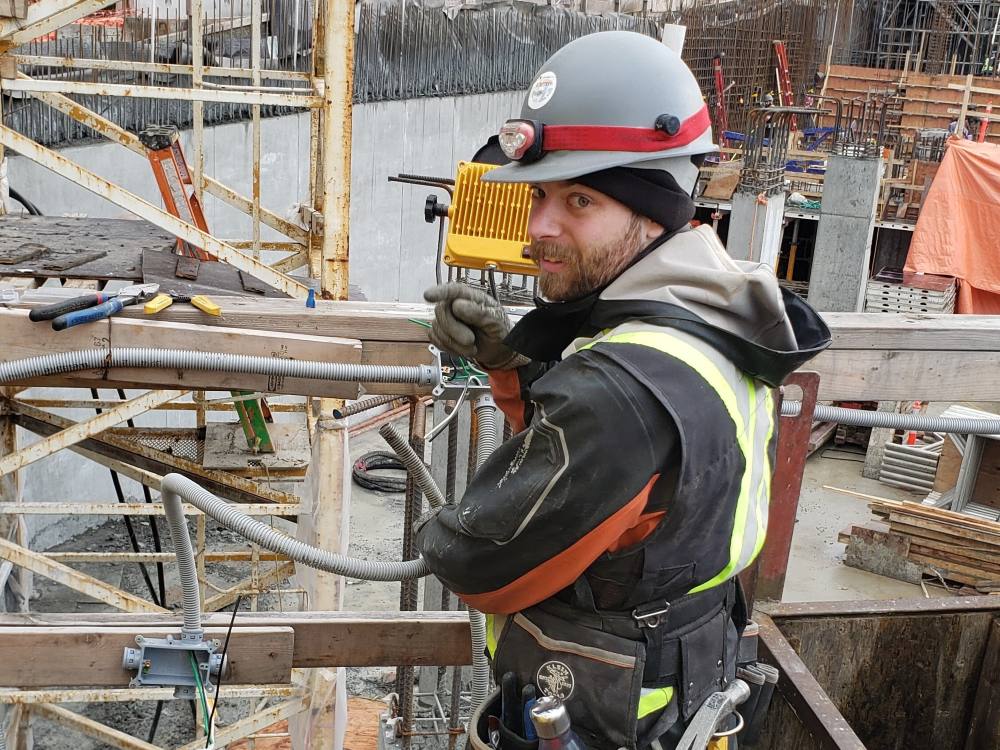On a Tuesday morning last fall at 7:25 a.m., my son, Emerson, takes his seat in a classroom in the electrical trades department at the British Columbia Institute of Technology. Gazing out the window, he sees a quiet campus that is still dark. As the other guys file in, and they are all guys, he reaches into his backpack. He pulls out a notepad, pen and an energy drink, then places them on his desk.
His instructor, a certified Red Seal electrician, begins what will be a three-hour lecture on programmable logic controllers. From time to time, he refers students to the text package, but otherwise uses few visuals.
Emerson, diagnosed with a subtype of attention deficit hyperactivity disorder called ADHD inattentive type, prefers active learning. It is one of the reasons he chose to pursue a career in the trades. He is now in the process of completing his apprenticeship in order to become an electrician.
In September 2017, we helped Emerson move from his childhood home in Gibsons, B.C., to his student residence at BCIT to start the six-month electrical foundations program which is designed for students with no work experience in the trades. When he completed that, he had to find his own job and housing. The first couple of years were hard, as new apprentices were always the first to be let go if cuts must be made.
Emerson’s apprenticeship requires him to complete 6,000 hours on the job as well as three additional levels of schooling, called second, third and fourth year. Each level consists of 10 weeks back in the BCIT classroom.
Every time Emerson went back to school, he had no job to return to and had to start looking again. If work dried up a couple of weeks early, he had to wait it out until school began. He tells me he wished that there was a way to use that time to get a head start on his studies.
He eventually settled in New Westminster, as he never knows where his next job will be. New West is central to work in many parts of the Lower Mainland.
Back in the lecture at BCIT, Emerson tries to take notes, but finds himself drifting off. “A lot of people in the trades have ADHD,” he tells me. “Classroom lectures don’t work for us.” As he takes a big slug of his energy drink, he notices several classmates nodding off.
After the break, class regroups in the computer lab to continue with the same topic. In the lab he can go at his own pace, which is a relief.
Though his instructors tell his class that the most valuable skills needed on the job are being able to work as part of a team and to solve problems collectively, they don’t organize lessons around group work or formal information-sharing.
As he works in the lab, Emerson worries about the afternoon’s multiple-choice test. He must maintain a 70 per cent average to pass fourth year. He is hovering just above that line. He understands the major concepts, but he feels like the test covers far too much material. He’s had no guidance on where to focus.
“There is not enough time in the day to study it all,” he says. “Not all of it is relevant, and there are red herrings tossed in to throw you off. If you study the wrong things, you are screwed.”
Some of his instructors won’t let students see their test results, citing the need to reuse tests. “If you are doing badly, there is no way to course-correct,” he laments. “They give you your mark and say, ‘Do better next time.’”
As both a high school teacher and contracted instructional designer, hearing these stories over the past five years of my son’s educational journey frustrates me. I know that the most important element in the learning process is getting useful feedback along the way. Though Emerson gets feedback while on the job as an electrician’s apprentice, he gets little in the classroom.
And it feels like going back in time to a bygone era of information scarcity, as though the last few decades of multimedia possibility no longer exist.
These days, a student’s phone is capable of delivering all of the necessary multimedia content for a trades program. A phone can also communicate learning back to the institutions responsible for assigning credit instead of requiring that tradespeople-in-training learn in person.
Photos, videos and audio files compiled on the job into a portfolio under the supervision of a journeyman tradesperson would go so much further in determining an apprentice’s competence than a multiple-choice test following a lecture.
But we don’t have that. Instead, there’s my son at the crack of dawn in a classroom, worried that a multiple-choice test could mean having to repeat this entire level again.
A disconnect between industry and school
Chad Flinn taught in the electrical trades department at BCIT for many years and is now the dean of trades at Medicine Hat College in Alberta. When I get him on the phone, one of his first comments in response to how we are doing in trades training is, “Honestly, we could be doing a lot better.” He goes on to tell me about the “disconnect between industry and post-secondary.”
Within the trades, he tells me, school is seen as a “hoop you gotta jump through” to get a pay raise.
One of the issues, he relates, is that “trades education tries to follow the academic model. The instructor lectures in front of the class.” If we are pulling apprentices out of their jobs and into school, he says, “We can do better than lectures. We should be helping them understand.”
He tells me that Alberta is “moving towards a competency-based portfolio," and that they are looking to “add video and picture-based assessment into it.”
In theory, we have a competency-based system in B.C. A journeyman must verify that an apprentice has developed competence in a range of areas. But Flinn tells me that “we don’t give [the competencies] the credence that they deserve.” In practice, it is little more than a checklist. Flinn admits that when he was an apprentice, a journeyman signed him off on work that he “had never touched.”
I tell him that my son has had similar experiences. During his regular days at work, he might not know who his supervising journeyman is.
Flinn is not surprised. “There is no accountability,” he says.
As for the electrical courses that Flinn used to teach, he says, “They need a lot of work.”
When I tell him my son’s experience of being overloaded with information with no idea of what to focus on, he confesses that this is likely because the instructors themselves “don’t know what needs to be emphasized.”
The core of the problem, Flinn tells me, is that the instructors “identify as tradespeople, not teachers.” They aren’t really thinking about the learning process, the lack of course design or whether multiple-choice exams are the best way to measure student learning.
An estimated 80,000 job openings on the horizon
All trades training in our province is overseen by SkilledTradesBC, until last year known as the Industry Training Authority. Recently, I spoke with Jenny Duncan, SkilledTradesBC’s director of external relations. One of Duncan’s biggest concerns right now is how to train enough skilled tradespeople to fill the estimated 80,000 vacancies in B.C. in the coming years.
Duncan tells me that one of the hurdles to promoting the trades as a career option is that “there is some work to be done around the perception of the trades,” especially amongst women and minorities.
Despite the fact that skilled trades are in demand and pay well, only 10 per cent of apprentices are women. Many are registered as cooks, bakers and hairstylists. Female apprentices in electrical, carpentry and plumbing have stayed in the single percentage points for years.
“We see real opportunity in bringing in more women and Indigenous people,” she tells me.
At present, more than 3,000 apprentices in B.C. identify as Indigenous. That’s a 128 per cent increase from 2013. SkilledTradesBC has brought trades training to Indigenous communities including the Tea Creek Farm in Kitwanga.
While recruiting appears to be doing better, retention isn’t. Duncan tells me that only 40 per cent of registered apprentices will achieve their certification within six years, which is down from 43 per cent a few years ago, with some of the decline due to the pandemic.
One service that SkilledTradesBC offers is apprentice advisors who assist with the process of getting through to certification, especially for those who are struggling. Yet, five years into his journey, my son had never heard of this, even when he failed one of his levels at school. Apparently, he would need to fail a level twice before being offered help.

We need more intentional course design
Since SkilledTradesBC is the organization ultimately responsible for the instruction of tradespeople in the province, I press Duncan about what I see as the huge chasm in the learning process. Who designs the courses?
She tells me that while her organization provides outlines to the post-secondary institutions, “We don’t design the courses themselves.”
She goes on to tell me that this is “left up to the experts at the post-secondary level” — the experts being the tradespeople who don’t see themselves as educators, according to Flinn.
This explains so many of my son’s difficulties. It is not so much that the material has been challenging for him as it has been irrelevant and confusing.
My two decades of working in instructional design have shown me that well-designed courses make a night-and-day difference in learning outcomes. Since the post-secondary schools have not stepped up in this regard, it seems the time for SkilledTradesBC to go beyond providing outlines and to take on this crucial task. If accessible, well-organized, high-quality materials were made available to instructors, they would use them.
If it were up to me, I’d scrap the entire four-year system and would replace it with a dozen or more modules that would each have to be mastered before going on to the next. Each module would be based on mastery, meaning a student would receive a pass once they have exhibited competence through a portfolio that a journeyman has certified.
Students could be given the option of taking the course in the classroom or completing it using a self-paced online format which would be optimized to run on smartphones. Institutions such as BCIT could repurpose a classroom as a learning centre where students could come for tutoring and to work on group projects or join field trips as necessary.
Whatever we choose to do as a province, all stakeholders know that the status quo isn’t going to cut it. Trades training needs an overhaul; it needs to be more accessible to bring in more people and more relevant to retain apprentices. It needs to be better designed to improve standards rather than just being a hoop to jump through to get a pay raise.
When I tell my son my proposed plan, his eyes widen. “That would be amazing,” he says.
He will be a journeyman soon. But higher standards are what he wishes for those who come after him. Especially the apprentices who will one day work under him. ![]()
Read more: Education, Labour + Industry

















Tyee Commenting Guidelines
Comments that violate guidelines risk being deleted, and violations may result in a temporary or permanent user ban. Maintain the spirit of good conversation to stay in the discussion.
*Please note The Tyee is not a forum for spreading misinformation about COVID-19, denying its existence or minimizing its risk to public health.
Do:
Do not: